Transition Metals - Colour in Transition Metal Ions (A-Level Chemistry)
Colour in Transition Metal Ions
Colour in Transition Metal Ions
Visible Light Spectrum
The visible spectrum of light ranges wavelengths of 400nm to 800nm.
Violet has the shortest wavelength (highest energy) and red has the longest wavelength (lowest energy).
Why do objects have colour?
Colour arises when visible light is shone on an object. Some of the energy from the visible spectrum of light is absorbed and the rest is transmitted or reflected.
This reflected light transmits particular wavelength of lights which correspond to a particular colour which is observed.
A sample will appear blue, because the energy from all the wavelengths of light except for blue are absorbed and blue light is transmitted.
Why do transition metals have colour?
Colour arises in transition metals because they have part filled d sub orbitals.
In a transition metal atom, all the d orbitals have the same energy. However, when transition metal ions bond with ligands, some of the five d orbitals increase to a higher energy, whilst the remaining orbitals remain at the ground state.
The difference in energy between the d orbitals is ∆E.
This occurs because electrons in the ligands repel some of the d orbitals closest to them.
The d orbitals are split into two different energy levels.
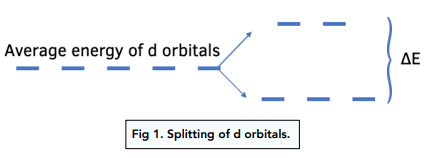
When visible light is shone on a sample of a transition metal complex, some of the electrons in the ground state absorb energy from the light and are promoted to the excited state.
The amount of energy absorbed is equal to the energy gap between the d orbitals ∆E.
The light transmitted is the colour observed.
The Energy Gap ∆E
Transition Metal Colours
The table below shows the wavelengths of different colours of light.
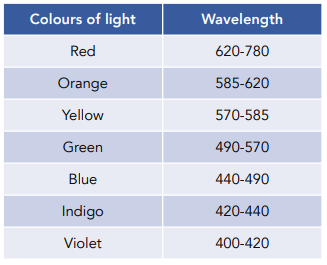
- The longer the wavelength of light, the lower the energy of the waves. Red light has a lower energy compared to violet light.
- The size of the energy gap between the 3d sub-orbitals allows light of different energies to be absorbed. The smaller the energy gap, the longer the wavelength of light e.g. red and orange region is absorbed. A greater energy gap allows light of higher energy and shorter wavelength to be absorbed, e.g. violet and blue.
Using a Colour Wheel
We can use a simple colour wheel to determine which colours are reflected, given the colours of light absorbed and vice versa.
Using the colour wheel in the diagram below, the colour of light directly opposite the colour absorbed, is the colour reflected and observed.
For example, if light energy between 580 and 620 nm (orange light) is absorbed by a transition metal complex, the colour of light opposite colour, blue is reflected.
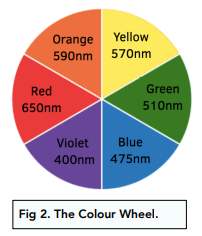
Calculating the Energy Gap
The equation which links the energy gap to the frequency of light is:

∆E = energy difference between d orbitals
h = Planck’s constant = 6.63 x 10-³⁴ J s
ν = frequency of light (Hz)
λ = wavelength of light absorbed (m)
c = speed of light (3.00 x 10⁸ m/s)
Factors Affecting Colour
The size of the energy gap is related to the colour observed.
There are different factors which affect the size of the energy gap: either changes in ligand, co-ordination number or in oxidation state.
Changes in Ligand
Ligands have different sizes, charges and electron densities. These will all affect the electrostatic forces within the 3d sub-orbital.
Large chloride ions produce a small increase in the energy gap, whereas small molecules like ammonia produces a much larger energy gap.
Example: [Co(NH₃)₆]²⁺ and [Co(H₂O)₆]²⁺
A solution of [Co(NH₃)₆]²⁺ appears to be orange-yellow as the ammonia molecules cause a higher energy gap, and absorb blue light of a shorter wavelength.
[Co(H₂O)₆]²⁺ is a pink colour as green-yellow light of longer wavelength compared to blue light, and smaller energy gap is absorbed.
[Co(H₂O)₆]²⁺ (aq) + + 6NH₃(aq) ⇌ [Co(NH₃)₆]²⁺ (aq) + 6H₂O(l)
Changes in Co-Ordination Number
The co-ordination number corresponds to the number of ligands that can fit around the central transition metal atom / ion.
The co-ordination number in turn affects the shape of the complex. Different co-ordination numbers will produce a different sized energy gap and hence colour.
Example: [Cu(H₂O)₆]²⁺ and [Cu(Cl₄)]²⁻
[Cu(H₂O)₆]²⁺ (aq) + 4Cl⁻ (aq) ⇌ [Cu(Cl₄)]²⁻ (aq) + 6H₂O(l)
octahedral/ blue tetrahedral/ yellow
The octahedral complex is blue as it produces a lower energy gap, so longer wavelengths of light are absorbed.
The tetrahedral complex is yellow as it produces a higher energy gap, absorbing blue light of shorter wavelengths.
Changes in Oxidation State
The oxidation state of the metal ion also affects the colour of the complex ion.
The higher the oxidation state the greater the electrostatic interaction with the ligands, and the higher the energy gap.
Example: [Fe(H₂O)₆]³⁺ and [Fe(H₂O)₆]²⁺
In the first example, the iron has an oxidation state of +3, and in the second case, the oxidation state is +2.
[Fe(H₂O)₆]³⁺ absorbs energy from the higher blue wavelengths of the spectrum, as the energy gap is greater, transmitting orange / brown light.
[Fe(H₂O)₆]²⁺ absorbs energy from the lower red range of the spectrum, with a smaller energy gap, and transmits green light.
Visible Light in Spectroscopy
Spectroscopy
The absorption of light is used in spectroscopy. This is used to measure the concentration of transition metal ions.
A simple colorimeter consists of a lamp as a source of white light which passes through a filter to produce light of one colour.
The sample will absorb this colour. The colour is chosen so as to produce maximum absorption.
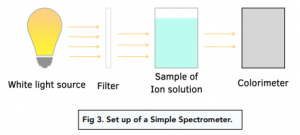
For example, if the colour of the solution is blue, it will absorb red light. A red filter is chosen, so that most of the red light is absorbed by the sample.
The greater the concentration of the solution, the more light will be absorbed and less will be transmitted.
Calibration Curve
A calibration curve is produced with standard solutions of known concentration. This curve can be used to determine the concentration of an unknown concentration.
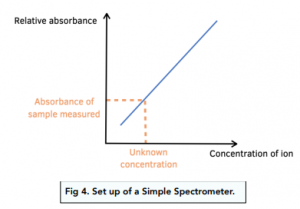
If the concentration of the sample is very low, a suitable ligand is used to intensify the colour.
Transition metals are a group of metallic elements found in the center of the periodic table. They have high melting and boiling points, good electrical conductivity, and exhibit unique properties such as magnetic and catalytic behavior.
Transition metal ions have color due to the absorption of specific wavelengths of light. This absorption is caused by the movement of electrons within the metal ion, which is unique for each metal ion. The color is a result of the energy difference between the electronic energy levels in the metal ion.
The number of unpaired electrons in a transition metal ion affects the color because it determines the energy difference between the electronic energy levels. More unpaired electrons result in a greater energy difference, which means that the metal ion will absorb a wider range of wavelengths, resulting in a more intense color.
The d-d transition is a term used to describe the movement of electrons within the transition metal ion. The d-d transition occurs when an electron moves from one d-orbital to another, causing an absorption of light and resulting in the color of the metal ion.
The crystal field theory is a theory used to explain the behavior of transition metal ions in complex compounds. It states that the presence of surrounding ligands will cause a shift in the electronic energy levels of the metal ion, affecting the energy difference between the levels and the color of the metal ion.
The coordination number, or the number of ligands surrounding the metal ion, affects the color of the metal ion because it determines the strength of the crystal field. A higher coordination number results in a stronger crystal field, which means that the electronic energy levels will shift more, resulting in a different color for the metal ion.
The color of transition metal ions can be used in A-Level Chemistry for various purposes, such as identifying unknown metal ions in solution, monitoring chemical reactions, and determining the concentration of metal ions in a sample. The unique color of each metal ion can be used as a characteristic feature to identify the metal ion present in a sample.






Still got a question? Leave a comment
Leave a comment